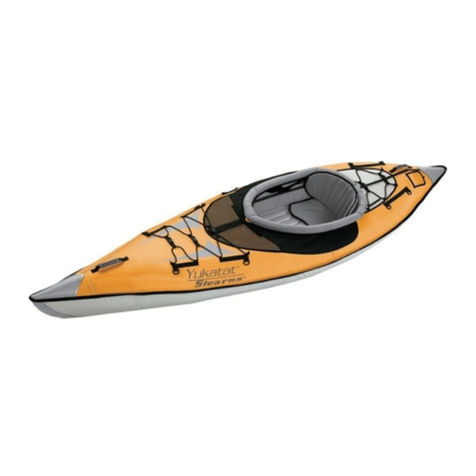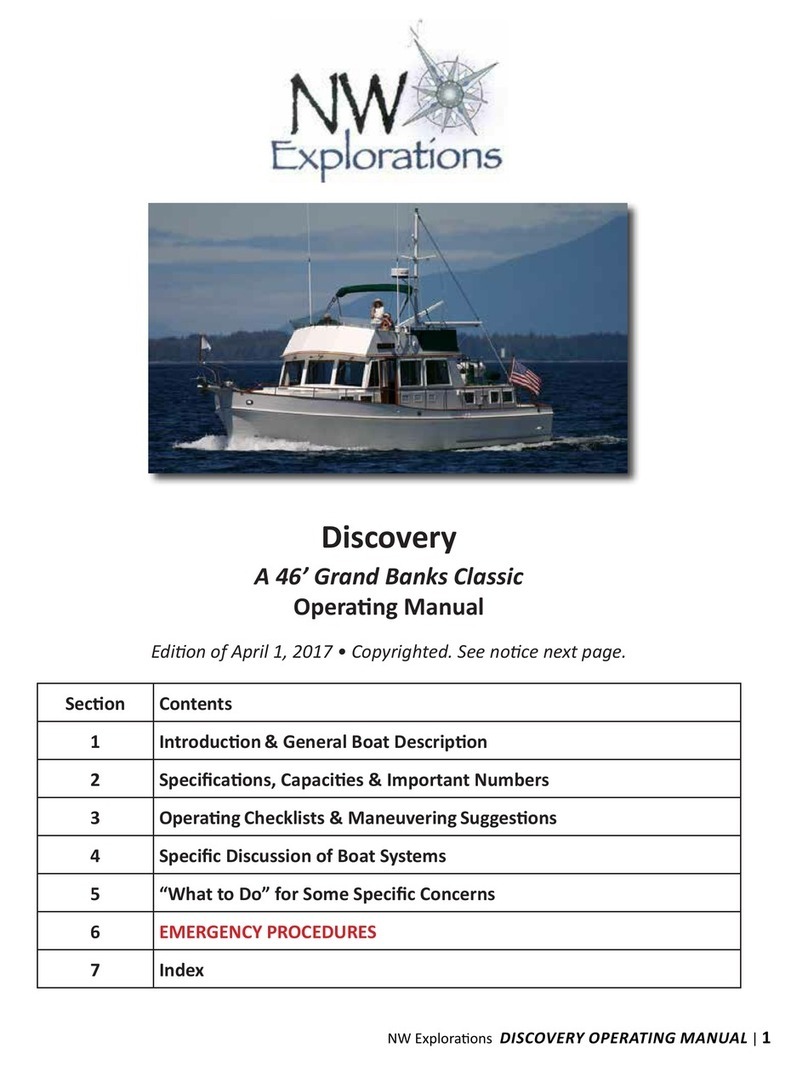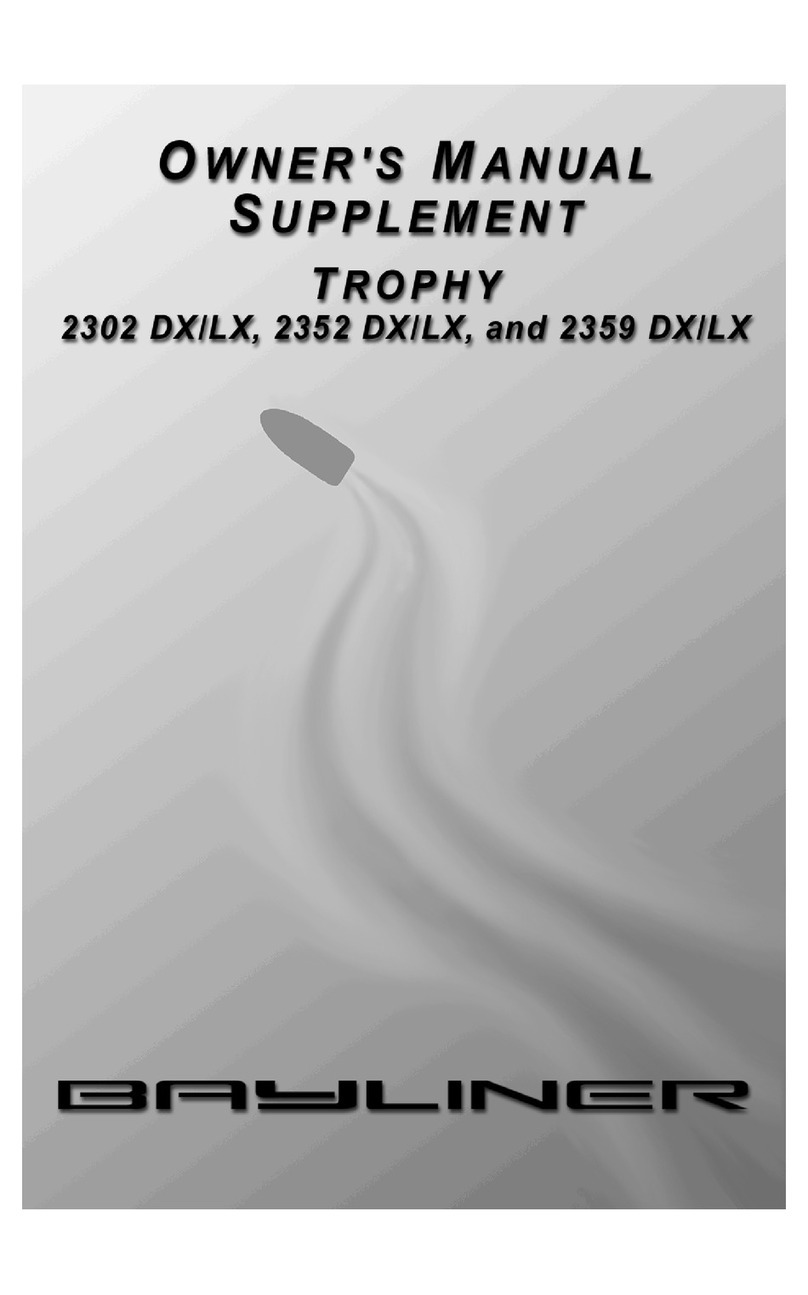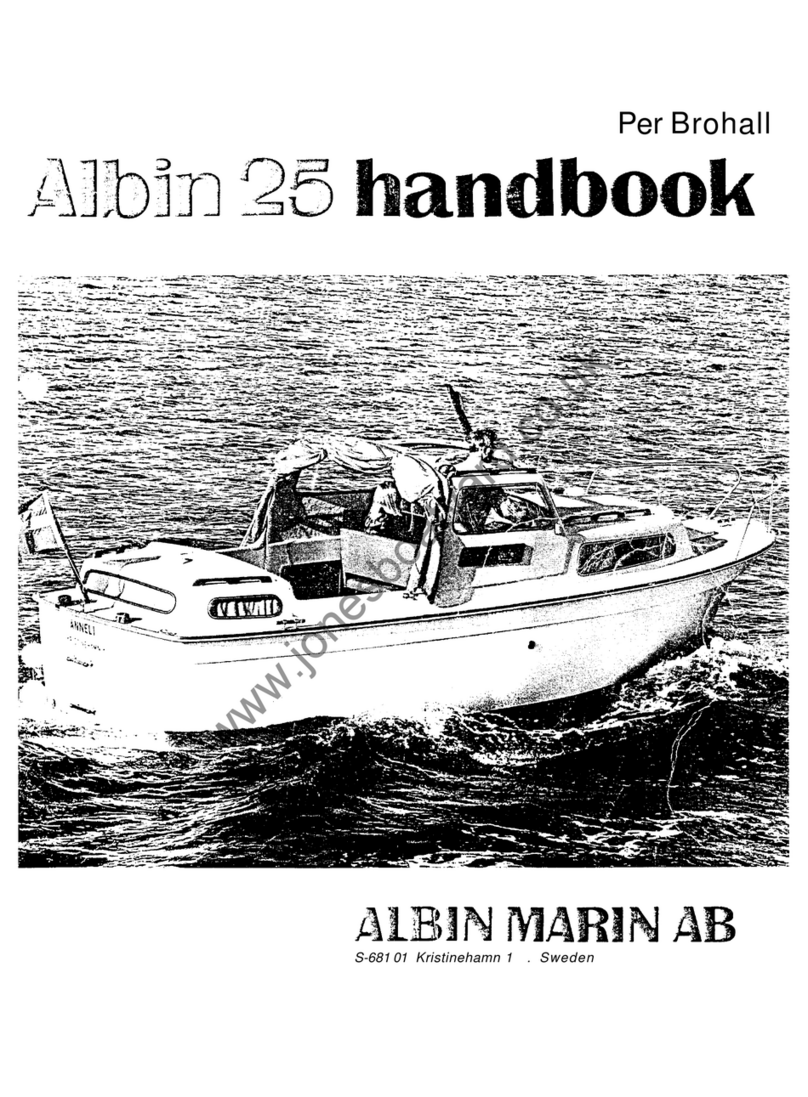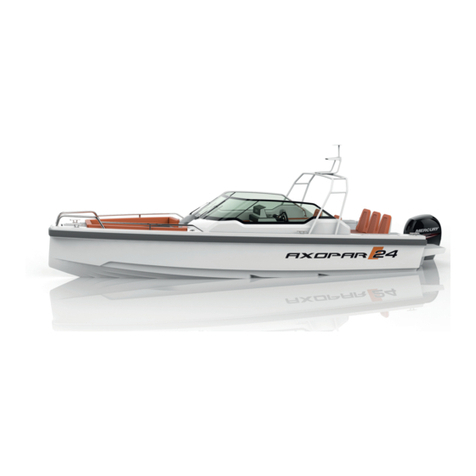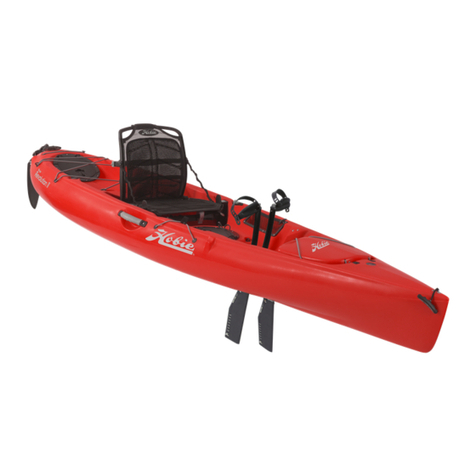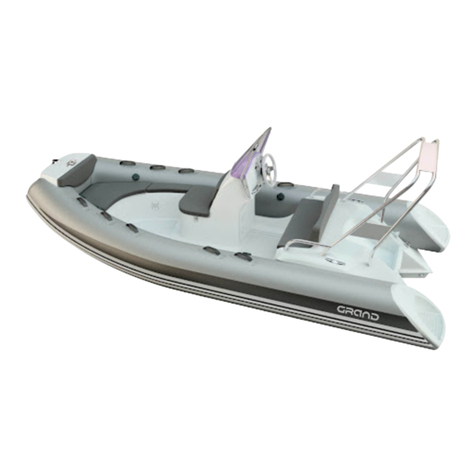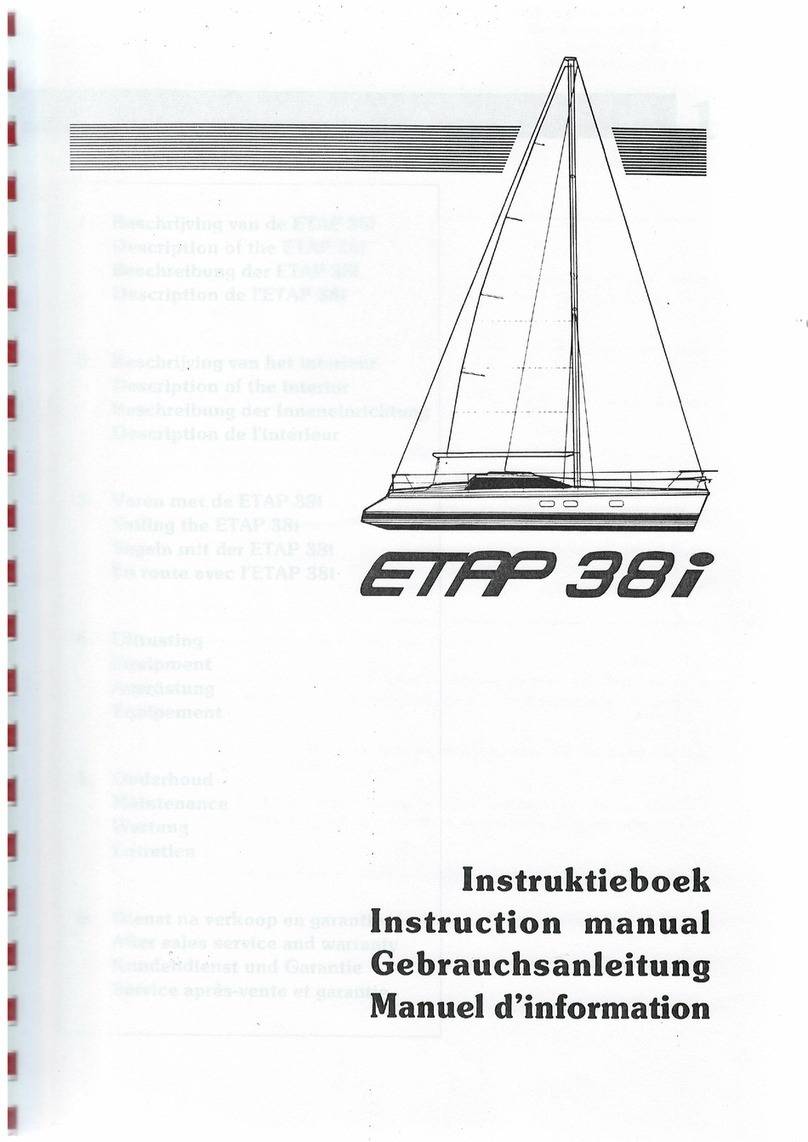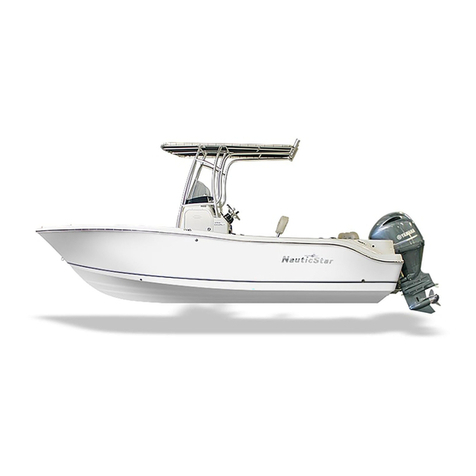Grand Banks Latis User manual

1
GRAND BANKS
OPERATIONS MANUAL
Welcome aboard!
We are happy you have chosen “Latis”for your vacation. We are sure you will
enjoy cruising the wonderful islands of the Pacific Northwest.
We trust this manual will help you become familiar with the boat. If you have
questions about the boat or about places to visit, please do not hesitate to ask any
of the AYC staff.
The Grand Banks 46 ranks among the finest cruising yachts ever produced. With
her timeless trawler profile, sea-kindly semi-displacement hull and elegant teak
interior the 46 Classic has defined cruising luxury since her introduction in 1985.
In the long elegant tradition of Grand Banks, Latis epitomizes the classic cruising
vessel of the Inside passage. She is comfortable, well laid out, and a great motor
yacht for exploring in grace and comfort. Latis is 46 foot Sedan Cruiser in a
traditional design with a comfortable salon, staterooms, and deck space with easy
walk around space on each side of the vessel.
We wish to fair winds and following seas

2
TABLE OF CONTENTS
Safety………………………………………………………………………… 4
Quick Start....................................................................................................... 5
Boat Operation................................................................................................ 9
Engine Inspection ........................................................................................ 9
Start-Up........................................................................................................ 12
Shutdown ..................................................................................................... 13
Before Leaving Dock................................................................................... 15
Getting Underway........................................................................................ 15
Cruising........................................................................................................ 16
Anchoring/Docking ..................................................................................... 19
Fueling ......................................................................................................... 23
Boat Electrical................................................................................................. 25
A.C. System................................................................................................. 27
Inverter......................................................................................................... 29
D.C. System................................................................................................. 31
Batteries ....................................................................................................... 32
Sanitation System…………………………………………………………….33
Marine Toilet ............................................................................................... 33
Holding Tank............................................................................................... 34
Y-Valve........................................................................................................ 35
Water Systems………………………………………………………………..36
Fresh Water Tanks....................................................................................... 36
Fresh Water Pump ....................................................................................... 36
Hot Water..................................................................................................... 36
Shower ......................................................................................................... 37
Wash-down.................................................................................................. 37
Galley…………………………………………………………………………38
Stove & Oven............................................................................................... 38
Refrigerator.................................................................................................. 40

3
Heating Systems……………………………………………………………...41
Diesel Heater................................................................................................ 41
Engine Heat.................................................................................................. 42
Bilge Pumps..................................................................................................... 43
Electronics……………………………………………………………………43
VHF Radio................................................................................................... 45
Depth Sounder ............................................................................................. 45
Radar............................................................................................................ 46
GPS / Plotter ................................................................................................ 46
Entertainment………………………………………………………………..45
AM/FM Radio and each other..................................................................... 46
Barbecue........................................................................................................... 47
Dinghy & Outboard........................................................................................ 48
Crabbing & Fishing........................................................................................ 49
Thru Hulls …………………………………………………………………...50

4
SAFETY
Safety is important in your daily cruising and should not be minimized. Review
where safety equipment is before cruising. Trying life jackets on is a good idea in
case they are needed latter.
Lifejackets are located in the stern lazarette and also on the fly bridge under
starboard aft facing seat. A few should always be out and ready, in fact we
recommend wearing them whenever working on the decks.
Flares are located in the salon in the upper cabinets on the portside of helm.
Fire extinguishers are located in the forward guest cabin, salon, aft cabin and
engine room.
The boat is equipped with a wireless LED searchlight. Rocker switch is marked.
Hand held remote located starboard side wheel.
It is a good idea to review what to do in case of an unexpected person in the
water... Man Overboard drills take a few minutes!
The throw ring is hanging outside the starboard doorway to the cabin. Again
practice is a good idea.
An air horn is located in the small stow away section above the wheel.

5
QUICK START
Before Starting Engines Checklist
Dinghy secured?
Grill covered?
All breakables stowed away?
Disconnect shore power, store cord
Power panel: double green dots ALWAYS ON; green dots ON for normal operation;
yellow dots ON as needed; red dots ALWAYS OFF
Open blinds for visibility
Check WOBBS: water (engine coolant), oil, belts, bilges and strainers
Check engine pads for signs of leaks
Close aft stateroom door to cockpit to keep diesel fumes out of the cabin
Starting Engines:
Put gear controls in neutral, throttle levers at slightly above “idle”
On “Engine Panel” of the DC Panel, flip starboard power switch to
ON for starboard engine. Buzzer will sound (low oil pressure
warning)
Push STARTING button for the starboard engine. When engine
starts, throttle back to a smooth idle. Buzzer should stop. Do not
try to start more than 30 seconds without a 2-minute “rest” period
Repeat procedure for port engine
Warm up at idle RPM
Check oil pressure for both engines: 30-90 PSI
Check for water coming out of both engine exhausts at the stern
Before Leaving the Dock:
Center the rudder
Untie mooring lines
Piloting from dock can be done at idle using forward and reverse of the twin props
Make sure engines are at idle before shifting gears. Make a slight pause at neutral before
shifting between forward and reverse
Underway:
Stow mooring lines and fenders
Keep watch for logs or debris in water
Monitor gauges
Keep engines RPM under 1300 until engines warm to 150 degrees
Normal RPM is between idle and 2200. ‘Latis’ cruises a very comfortable 8 knots @
1600 RPM with fuel consumption about 3 gals per hour. Do not exceed 2300 RPM for
more than 30 minutes – check engine temps!
Normal readings: Engine Temp 175-190 Oil Pressure 30-90 psi

6
Approaching Dock:
Put fenders out. We generally put fenders down on both sides when maneuvering in
close quarters. Have extra fenders ready if the vessel will make contact with the dock or
another boat
Attach bowline to cleat and run line out through the hawsehole, OUTSIDE the bow rail
and OUTSIDE fender lines toward mid-ship. Same procedure for stern and spring lines.
Station a member of the crew at mid-ship to tend the mooring lines
Engine throttle should be dead slow and rudders centered. Close maneuvering is best
done with forward and reverse maneuvers with twin props.
Mate ready to step off swim step (No leaping across water to dock!) and secure spring
line (most circumstances), then bow and stern. Often you will find a friendly person to
catch your dock lines and help you secure them.
Position mate on deck with a spare large fender with line attached.
Upon Arrival at Marina:
Secure all lines. Stern, bow and two spring lines at a minimum
If bow-in, be sure anchor is not protruding over dock walkway
Turn off engines (see “Stopping Engines” below)
Turn off electronics at both helm stations; replace covers
Connect shore power. First to the boat, then to the shore receptacle (30 amp power for
Latis)
If at an unfamiliar marina, be sure to check polarity of the shore power connection before
turning on the breaker at the dock
Stopping the Engines:
After operating at cruising speed, allow engines to idle a few minutes to cool down before
shutting them down (this usually happens naturally while tying dock lines or setting anchor).
You can also turn on the engine room VENTS to help cool the engine room.
On Engine Panel turn the far left STOP SOL breaker to the ON position
Push the port STOPPING button. Low oil pressure buzzer will sound
Turn off the port engine power breaker. Buzzer will stop
Push the starboard STOPPING button. Buzzer will sound
Turn off the starboard engine power breaker. Buzzer will stop
Turn OFF the STOP SOL breaker
Daily (Overnight) Checklist in Marina:
AC Input ON for shore power
Inverter ON – be sure it is charging
Keep an eye on the holding tank. The meter is located in the master stateroom head on
the sink vanity

7
Daily (Overnight) Checklist at Anchor or Buoy
Anchor light ON during hours of darkness.
Turn off unnecessary electrical items. Even unplugging appliances not in use will help
reduce the drain on battery power - turn off the power strip for the microwave and coffee
maker
Keep an eye on the holding tank. The meter is located in the master stateroom head on
the sink vanity
Mooring at Anchor:
All anchoring should be done with the engines running as the windlass uses a lot of
power
Turn on WINDLASS POWER on panel to the right of the helm. Anchor is lowered with
foot controls on bow deck below the Windlass. Lower the anchor while backing the boat
slowly from anchorage
Foot controls on bow below the windlass
Mate on bow to monitor length of chain going out and to troubleshoot if it gets tangled.
Anchor line is marked as indicated in the Operations Manual
When desired chain length is out, stop Windlass
Attach snubber lines to anchor chain. Use of snubber lines will give a more comfortable
anchorage as they act like springs to absorb tension on the line. Attach snubber lines to
the anchor chain beyond the anchor roller in order to take the “load” off the Windlass.
Secure snubber lines through bow hawseholes and to bow cleats.
Run out enough chain to take the tension off the Windlass
Back the boat at idle using just one engine to test the set of the anchor. Use a
combination of sighting objects in the harbor and GPS to confirm anchor set
Turn OFF Windlass power at the panel
STOP engines

8
First Thing Each Day:
If at anchor, turn OFF the anchor light
Check battery reserve on inverter panel (port side of wheel). If less than 12 volts,
consider starting engines to begin recharging house batteries before using any additional
electricity
Check fresh water tank level
Check holding tank gauge. If near full, it will be necessary to pump out very soon
Before Leaving Vessel:
DC power panel: turn freshwater (F.W.) Pump OFF
Cover electronics screens at both helm stations
Close curtains
Lock the cabin doors
If you are docked at an island, make sure no food is left out or accessible as critters will
come aboard

9
BOAT OPERATION
ENGINE INSPECTION
Remember to check WOBBS every morning: Water (Coolant), Oil, Belts, Bilge
and Strainer.
Access to the engine compartment is through the hatch near the port door. There
are wooden stairs that can be removed when working by raising the silver latch and
lifting the ladder up. You do not have to unscrew the bolts at the bottom step.
Water (Coolant):
This engine does not lend itself to an easy check of the level of Coolant in the
coolant reservoir.
The best method to check for coolant is to place one finger inside the reservoir. If
your finger touches coolant at any point when inside the reservoir, the coolant level
should be adequate.
If you notice overheating please open the coolant cap located towards the front of
the engine once the engine has cooled down.
Oil:
Port Engine Starboard Engine

10
Check the level of Oil in each engine by using dipsticks located on the side of each
engine, easily accessed from the center of the boat.
Look at the etch marks on each dipstick that indicate the proper oil level.
Only add oil if level is near the lower mark and DO NOT OVERFILL! Please
use a paper towel or oil rag, not the dish towels, to wipe off the dipstick. Ensure
the dipsticks are fully seated back into the tube when done.
Belts:
Check condition and tightness of the belts. If they feel tight, that’s about right.
Bilge:
Check the lower areas of the engine room for excess water. You will note the
amount when you first start and after that if it increases, check for causes.
Bilge under floorboard forward engine room
There are sorbs (diapers) under each engine. They will help identify if there are
leaks in the engine and to determine where they may be. Under normal operation
there are minimal drips, however if an engine is dripping significantly check for
the probable cause.
A manual bilge pump is located under the hatch near the entrance to the lower
stateroom.

11
Strainer:
Ensure the valve (yellow handle) on each raw water thru-hull is in the “OPEN”
position (lever in-line with valve).
Observe the metal screen through the glass of each strainer for debris. At times it
may become necessary to clean the strainer due to a buildup of debris clogging the
system. It is important to keep a close eye on sea strainer condition, and if they
need a cleaning follow these simple directions:
1. Opposite the yellow handle on the base is a small T-handle. Loosen this
about two turns, note that some water may leak through. Close the seacock,
(yellow valve).
2. Open the strainer cover using the spanner wrench located under the step
inside the starboard door.
3. Clean the strainer thoroughly.
4. Reassemble, remembering to reopen the seacock and tighten the T-handle
once the strainer is completely put back together.
T-handle
Open

12
START-UP
The engines should be started from the lower helm station.
1. Turn battery selector on the DC panel (port side of helm) to “On”.
2. GEARSHIFT in neutral.
3. THROTTLE should be just above the idle position.
Normally, plan to start the STARBOARD engine first.
4. Make sure the STOP SOLENOID switch is ON
5. Turn the STARBOARD power switch ON
6. Press the STARBOARD STARTING button.
You should hear a loud buzzing noise, this is
normal, it’s the low oil pressure alarm.
7. After a few seconds the buzzer should stop
indicating the oil pressure is normal. If it does
NOT stop, turn off the engine by holding the
STOPPING button. Determine why the buzzer
did not stop. If because of no oil pressure, see
Note below.
8. Turn the PORT POWER switch ON
9. Press the PORT STARTING button and again
note the buzzer.
LOWER SECTION OF ENGINE PANEL
Raise the engine speed to between 700-800 rpm on the TACHOMETER.

13
Check the engine exhausts at the stern. There should be water burping out of the
exhausts. If there is no water coming out, shut down the engines and see NOTE
below.
NOTE--If oil pressure is low, shut down the engine, and inspect engine
compartment and look for possible cause (for example, loss of oil.)
Caution -- If an engine is overheating or there is lack of raw water expelled in the
engine exhaust, stop the engine immediately. Recheck the raw water-cooling
system to ensure the seacock on the strainer is open (handle in-line with valve).
Next, check the raw water strainer for debris. If necessary, close the seacock,
remove the strainer, clean, re-assemble, and reopen the seacock. Restart the engine
and re-check water flow from the exhaust. If water is not flowing properly, the
Raw Water Pump may need to be serviced. Call AYC (360-293-4555).
When reachingcruising speed turn on the synchronizers,the port engine is a slave to
the starboard engine
Turn off thesynchronizerswhenmaneuvering
Checkthe waterlevelandthe oil leveldaily
Cruising speed
a. 1600 rpm (9.5k..5-6gph)
b. 1800 rpm (10K..8-9 gph)
c. 2100 rpm (11K..12-13gph)

14
SHUT-DOWN
After operating at cruising speed, allow engines to idle a few minutes to cool down
before shutting them down (this usually happens naturally while tying dock lines
or setting anchor). You can also turn on the engine room VENT switch to help
cool the engine room.
GEARSHIFT in neutral position.
THROTTLE in idle position.
On the engine panel make sure the STOP SOL is
UP, or ON.
Turn off engines by pressing the STOPPING
button for each engine. Low oil pressure buzzer
will sound.
Silence buzzer by turning the POWER switches
OFF.
Turn the STOP SOL breaker OFF.

15
BEFORE LEAVING DOCK
DISCONNECT the shore power cord and stow it aboard. When disconnecting
from the dock, make sure to turn the POWER OFF at the dock breaker before you
pull out the power cord. This will prevent a ‘short’ between the power cord legs.
Forward power connection Aft power connection
Close the portholes, windows, and forward hatch.
Set up VHF radio and electronics (GPS, radar, camera)
Brief crew on what you expect from them to depart, and if you need help with
lines, fenders etc. It’s not good to have too many people involved as this can cause
confusion and accidents. It is up to the captain to double check. Too many
accidents have occurred when a boat leaves with a line still tied to the dock.
Make sure all items that can break are stowed away safely
GETTING UNDERWAY
All close quarters maneuvering should take place at the upper (fly bridge) helm for
better visibility.
Shift only at idle speed to avoid transmission damage.
Once outside the marina, stow fenders and lines.

16
CRUISING
Maximum cruising speed is about 1800 RPM. If you run at a slightly slower RPM
(1400) you will cruise at about 7 knots and use a little over 2 gallons per hour.
Speed will vary depending upon the weight, currents and weather conditions.
NOTE: -- Higher engine speed causes higher temperatures (and possible damage)
as well as a substantial increase in fuel consumption.
Synchronizers
1. Set the engines to the approximate cruise settings
2. Pull the switch near the engine alarm panel at the lower helm or in the middle of
alarm panel at upper helm (the pilot light will go on)
3. Push the “Slave” control all the way forward (This will save stress on the
synchronizer as it adjusts the slave engine’s speed). You now control the speed of
both engines with the “Lead” engine.
Disengage the synchronizer
1. Pull back “slave” lever until you feel resistance
2. Push in the switch. The engine throttles are now once again independent.

17
Auto Pilot
Autopilot can assist when taking long trips.
Steers best in low range, 3 for smooth water
To transfer the autopilot from the lower station to the fly bridge, turn the
fly bridge on and it willturn the lowerstationoff. When yougobackto the
lowerstationthe autopilotwill be off andthe modewill bein auto, turnto
off and backtoauto tooperate
The motor and clutch are located below the lower steering console.
Stabilizers
Stabilizers are helpful in rough waters.
When
running
turnrocker switch to "on".When
maneuvering
turnthe rocker
switch to center or "off"
When running,check theoilleveland temperatureonceaday at thecontrolunit in the
engine room .The cooling water takes off the port engines salt water pump and is
discharged onthe port sideahead of therefrigeration pump discharge.

18
Trolling Valve for fishing
NEVER RUN THE ENGINEOVER1000 RPMWITHTHETROLLING
VALVE ENGAGED
The trolling valve is located on the port engine transmission.
Thetrollingvalveoperatesbyallowingthe oil to bypassin thehydraulic transmission.
Thepush and pull silver operating leveris onthe starboardside of thelower steering
station.
Out is engaged and all the way in is on. (normal)
For trolling speed;
1. Shut down the starboard engine
2. Reducethe port engine to 500rpmandleaveingear
3. Pulloperating lever all the way out
4. Adjust rpm for the speed (NEVER OVER 1000 RPM)
5. Toresumenormalspeedpushoperatingleverallthewayin andrunatnormal rpm

19
ANCHORING
Anchoring in the Pacific Northwest can be accomplished with careful planning and
patience. The tides, currents, and winds need to be taken into account when
choosing the best spot. There are many guidebooks and online recommendations
for anchoring in the San Juan’s. Taking the extra time saves worry down the road.
Use the charts, onboard electronics, and your eyes to find your spot. Gravel, sand
and mud are preferable. As you’re getting ready to set make sure you have room to
swing on your anchor without hitting anything.
Using the windlass foot controls on the bow lowers the anchor. The windlass
power switch is located on the PROTECTION PANEL located to the right of the
helm. Turn it ON. It is NOT a good practice to use the windlass controls at the
helm as it could be dangerous for the crewmember at the bow.
LOWERING THE ANCHOR
At the bow, tap gently on the down foot control to lower the anchor. If necessary,
guide the anchor over the anchor roller to prevent binding on the pulpit.
Let out sufficient ANCHOR RODE before setting the anchor. The chain is marked
with strings
5 fathoms=1 string
10 fathoms=2 strings
15 fathoms=3 strings
20 fathoms=4 strings
25 fathoms=5 strings
30 fathoms=6 strings
35 fathoms=7 strings
Use about 5 to 1 scope depending on the weather. When anchor reaches bottom
engage reverse for five seconds at a time until the chain starts to pull straight off
the bow toward the anchor. When anchor holds set the anchor with gentle tugs,
then verify that the anchor has held by having one engine in IDLE reverse and
verify the boat is NOT moving backward. If you hear clunks and the chain releases

20
the anchor may be dragging over rocks. Better to retrieve and try again, sometimes
it takes a few tries so be patience. Taking the time saves the worry.
Folks often rig a shoreline from the stern of the boat to shore.
RAISING THE ANCHOR
Before raising the anchor, ALWAYS start the engines as the windlass uses a large
amount of power.
Do not overload when pulling the anchor, run up on the anchor so the windless is
not overloaded.
NEVER PULL ON THE ANCHOR USING THE ENGINE (RPMS) FOR
MORE THAN 5 SECONDS. PULLING WITH THE ENGINE FOR A
LONG PERIOD CAN CAUSE DAMAGE . ALWAYS KEEP IN IDLE
WHILE RISING ANCHOR WITH THE WINDLASS.
If you are bringing up more than 100’ of chain, it may be necessary to open the
chain locker at the head of the v-berth to redistribute the chain as it may “pile-up”
in the locker. Please remove the v-berth cushions and place a sorb or towel under
the door before opening the chain locker to catch any water or debris.
Turn ON the windlass switch. As you drive the boat toward the anchor, press the
UP control to take up slack. Give the windlass short rests as you are pulling the
anchor up.
As the anchor rises, be careful not to allow it to swing against the hull. Guide the
anchor onto the roller
Table of contents
Other Grand Banks Boat manuals



